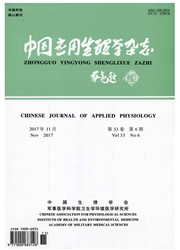

 中文摘要:
中文摘要:
目的:利用秀丽线虫研发合适的低氧损伤模型,以更好地揭示低氧生理和低氧病理的分子机制。方法:通过对秀丽线虫进行不同时间的低氧处理,系统观察线虫的死亡率、运动功能、细胞形态及相关蛋白表达水平的变化,分析低氧对线虫的损伤情况。结果:氧浓度为0.2%的物理性低氧可引起秀丽线虫多种细胞形态发生变化,进而导致线虫死亡,且死亡率随低氧时间延长而持续增加,同时低氧诱导因子(HIF-1)的表达显著上调。进一步通过神经元特异性转基因(绿色荧光蛋白)株系观察到低氧可引起神经元特征性损伤。结论:成功建立有效、简便易行的线虫物理低氧损伤模型,可用于低氧病理和低氧应答分子机制研究。
 英文摘要:
英文摘要:
Objective: To develop a suitable hypoxic injury model, which is important for revealing pathological molecular mechanism of hypoxia. Methods: We focused on C. elegans by treatment with different hypoxie times and systematically observed mortality, movement, cellular morphology and the related-pretein expression of the animals. Results: We demonstrated that hypoxia (0.2% partial pressure of oxygen) induced morphological cell defects, and then leading to death of C. elegans. The mortality of C. elegans increased along with hypoxie time, while hypoxia-inducible factor(HIF-1) was significantly up-regulated. In addition, by using neuron-specific transgeuic worms with green fluorescent protein- we observed the neuron-specific injury caused by hypoxic stress. Conclusion: We successfully established an effective, convenient physical hypoxic model of C. elegans, which will facilitate the studies of hypoxic pathology and molecular mechanisms of hypoxic response in the future.
 同期刊论文项目
同期刊论文项目
 同项目期刊论文
同项目期刊论文
 期刊信息
期刊信息
